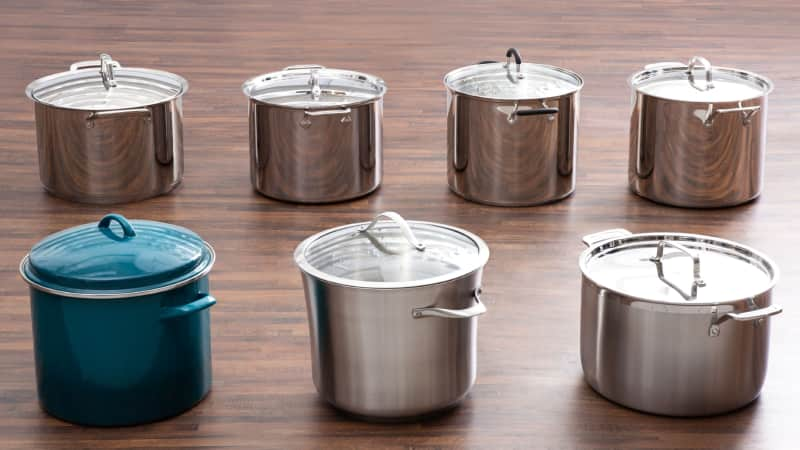Classic Chicken Broth
Recipe
Which stockpot is best? To find out, we boiled, stirred, and sautéed in every pot, ending up with gallons upon gallons of chicken stock and a new winner.
Last Updated Sept. 1, 2022. Appears in America's Test Kitchen TV Season 21: Salmon Steaks Done Right

A stockpot is like an umbrella: You don't use it often, but it's invaluable when you need it. My own is oft-ignored, usually hidden in a cabinet, but it becomes a star player when I start making chicken stock in colder months. A large pot like this is also handy for cooking multiple ears of corn on the cob, whole lobsters, or big batches of pasta. You can also use it when making stew or chili for a crowd.
We previously tested stockpots, but most of the models we looked at have been discontinued, so we decided to retest. We focused on finding the best 12-quart stockpot because we think it's the most useful size—big enough to accommodate most jobs yet small enough to easily store. We purchased seven widely available models, priced from about $30 to about $400, and used them to boil bulky ears of corn, cook thin strands of angel hair pasta, sauté onions, and simmer chicken wings and backs in water for 5 hours. Our efforts resulted in not only gallons of fragrant chicken stock but also a new favorite stockpot.
We conducted two tests to examine how well each of the stockpots conducted heat, timing how long it took to bring 2 quarts of water to a boil over high heat and how long it took to sauté 1 cup of onions to an even golden brown over medium-low heat.
In the water test, the top-performing pot brought water to a boil more than 5 minutes faster than the bottom-performing pot. In the onion test, the top performing pot browned the onions about 2 minutes faster than the bottom-performing pot. Looking at these results for each pot, it didn't take much sleuthing to figure out the reason behind these differences: the thinness of a pot's base. The thinner a pot's base, the faster it heated the water and the onions. Our quickest-heating pot's base was 3/16 inch thick, and the base of the slowest-heating pot was twice as thick at ⅜ inch. While bringing water to a boil quickly in the pots with thin bases was a plus, we had to keep a close eye on onions we were sautéing in these pots, as they were more prone to scorching. In the end, heating time wasn't a significant factor in our choice of a favorite pot.
Another thing we learned while sautéing onions: The sole enameled pot didn't handle heat as well as pots with plain stainless-steel interiors. The light-colored enamel began turning brown immediately when placed over heat, even though the burner was set to medium-low. We much preferred the stainless-steel pots in our lineup for their ability to withstand heat without discoloring.
Stockpots are large pieces of ...

The mission of America’s Test Kitchen Reviews is to find the best equipment and ingredients for the home cook through rigorous, hands-on testing. We stand behind our winners so much that we even put our seal of approval on them.

This is a members' feature.